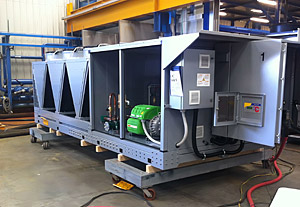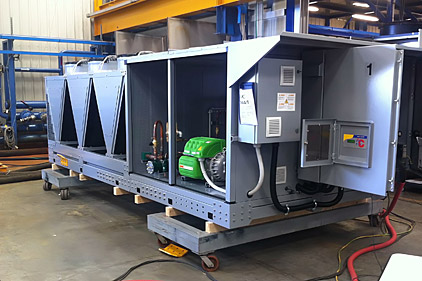
|
| British-based Klima-Therm has installed what it said was the world’s first Turbomiser chillers equipped with an HFO refrigerant. |
The company has installed two of the HFO chillers in a department store in Milton Keynes, a city about 50 miles northwest of London. The company also said it received a second order for an installation of HFO Turbomiser machines for a retail development in the southwest part of England.
Tim Mitchell, Klima-Therm sales director, said, “The HFO Turbomiser is a very attractive combination. In its favor is the exceptional and proven energy performance of Turbomiser, which can cut energy use by up to 60 percent, coupled with the very low global warming potential [GWP].”
The refrigerant used was HFO-1234ze with a GWP of 6 compared to 1,300 for HFC-134a. (Another low-GWP refrigerant, HFO-1234yf, is being introduced in automotive a/c in Europe.)
“This is a huge difference in terms of environmental acceptability. End users have to take notice — and they are,” said Mitchell.
The first project involved the installation of two chillers as part of a store refurbishment. Each of the chillers is rated at 230kW, making a combined cooling capacity of 460kW.
The chillers will supply all the cooling needs for the store, delivering comfort cooling via the store’s chilled-water-based air conditioning system.
Unit Design
Tests carried out by manufacturer Geoclima at its testing facility in Italy have demonstrated that the HFO Turbocor-based Turbomisers operate with a full-load COP of around 4, Mitchell said.
It is known that use of R-1234ze results in a loss of cooling capacity of around 24 percent compared with HFC-134a across various application conditions, he said. But he noted that means power absorbed is around 27 percent less, giving an overall COP for the HFO actually better than R-134a.
“The design of the new HFO Turbomiser compensates for the reduction in capacity, employing slightly larger heat exchanger surfaces and clever design and component layout,” said Mitchell. “The HFO Turbocor compressor employed, type TG310, is based upon the existing model TT350.”
As a result there will be a slight cost premium over the standard Turbomiser chiller running on R-134a, he noted. However, Klima-Therm believes cost comparisons per kW of cooling compared to other low GWP solutions will be attractive, especially given the environmental benefits of using low-GWP HFOs.
A further important benefit of the HFO solution is that it may overcome the equipment siting and charge capacity restrictions that accompany the use of other refrigerants, such as hydrocarbons, the company said.
Klima-Therm said that HFO-based chillers can be as flexible in use as standard HFC machines.
Publication date: 9/24/2012


Report Abusive Comment